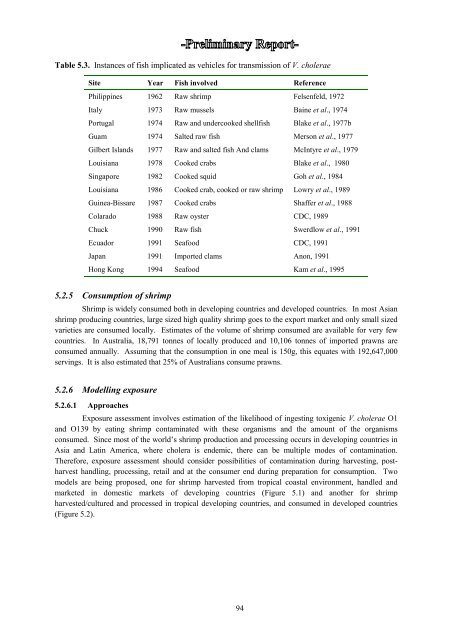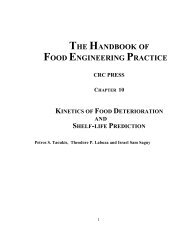Vibrio in seafood - FAO.org
Vibrio in seafood - FAO.org
Vibrio in seafood - FAO.org
You also want an ePaper? Increase the reach of your titles
YUMPU automatically turns print PDFs into web optimized ePapers that Google loves.
Table 5.3. Instances of fish implicated as vehicles for transmission of V. choleraeSite Year Fish <strong>in</strong>volved ReferencePhilipp<strong>in</strong>es 1962 Raw shrimp Felsenfeld, 1972Italy 1973 Raw mussels Ba<strong>in</strong>e et al., 1974Portugal 1974 Raw and undercooked shellfish Blake et al., 1977bGuam 1974 Salted raw fish Merson et al., 1977Gilbert Islands 1977 Raw and salted fish And clams McIntyre et al., 1979Louisiana 1978 Cooked crabs Blake et al., 1980S<strong>in</strong>gapore 1982 Cooked squid Goh et al., 1984Louisiana 1986 Cooked crab, cooked or raw shrimp Lowry et al., 1989Gu<strong>in</strong>ea-Bissare 1987 Cooked crabs Shaffer et al., 1988Colarado 1988 Raw oyster CDC, 1989Chuck 1990 Raw fish Swerdlow et al., 1991Ecuador 1991 Seafood CDC, 1991Japan 1991 Imported clams Anon, 1991Hong Kong 1994 Seafood Kam et al., 19955.2.5 Consumption of shrimpShrimp is widely consumed both <strong>in</strong> develop<strong>in</strong>g countries and developed countries. In most Asianshrimp produc<strong>in</strong>g countries, large sized high quality shrimp goes to the export market and only small sizedvarieties are consumed locally. Estimates of the volume of shrimp consumed are available for very fewcountries. In Australia, 18,791 tonnes of locally produced and 10,106 tonnes of imported prawns areconsumed annually. Assum<strong>in</strong>g that the consumption <strong>in</strong> one meal is 150g, this equates with 192,647,000serv<strong>in</strong>gs. It is also estimated that 25% of Australians consume prawns.5.2.6 Modell<strong>in</strong>g exposure5.2.6.1 ApproachesExposure assessment <strong>in</strong>volves estimation of the likelihood of <strong>in</strong>gest<strong>in</strong>g toxigenic V. cholerae O1and O139 by eat<strong>in</strong>g shrimp contam<strong>in</strong>ated with these <strong>org</strong>anisms and the amount of the <strong>org</strong>anismsconsumed. S<strong>in</strong>ce most of the world’s shrimp production and process<strong>in</strong>g occurs <strong>in</strong> develop<strong>in</strong>g countries <strong>in</strong>Asia and Lat<strong>in</strong> America, where cholera is endemic, there can be multiple modes of contam<strong>in</strong>ation.Therefore, exposure assessment should consider possibilities of contam<strong>in</strong>ation dur<strong>in</strong>g harvest<strong>in</strong>g, postharvesthandl<strong>in</strong>g, process<strong>in</strong>g, retail and at the consumer end dur<strong>in</strong>g preparation for consumption. Twomodels are be<strong>in</strong>g proposed, one for shrimp harvested from tropical coastal environment, handled andmarketed <strong>in</strong> domestic markets of develop<strong>in</strong>g countries (Figure 5.1) and another for shrimpharvested/cultured and processed <strong>in</strong> tropical develop<strong>in</strong>g countries, and consumed <strong>in</strong> developed countries(Figure 5.2).94














